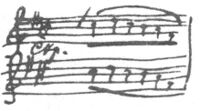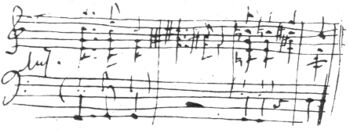Letter 1518
| Date | 24 June/6 July 1880 |
|---|---|
| Addressed to | Karl Albrecht |
| Where written | Kamenka |
| Language | Russian |
| Autograph Location | Moscow (Russia): Russian National Museum of Music (Ф. 37, No. 37) |
| Publication | Чайковский на Московской сцене (1940), p. 287–290 П. И. Чайковский. Полное собрание сочинений, том IX (1965), p. 158–161 |
Text and Translation
| Russian text (original) |
English translation By Luis Sundkvist |
Каменка. 24 июня 1880 г. Ваше Высокопревосходительство
Милостивый Государь Константин Карлович! Имею честь на вопросы Ваши ответствовать по пунктам: 1) В вальсе «Онегина» указания мои сделаны не неряшливо, как Вы изволите говорить, а совершенно точно, т. е. в скрипках legato только там, где это означено, следовательно, только в этом месте: В духовых же оно гораздо чаще. Отчего Вы полагаете, что духовые не могут делать legato в одно время с staccato или détaché скрипок? Если у меня в скрипках над пассажами не стоит никакого знака, т. е. ни точек, ни точек с лигой, ни просто лиги, так, следовательно, я желаю, чтобы они играли каждую ноту отдельным смычком, но весьма часто случается, что духовые, играющие в унисон с ними тот же пассаж, я заставляю играть legato, и решительно не понимаю, почему Вы подобной комбинации не допускаете? Вообще, я сознаюсь Вам, что относительно смычковых указаний я очень несведущ, но не неряшлив. Очень часто я не знаю хорошенько, как выразить то, что мне нужно, т. е. избрать ли один из следующих способов:Но никогда не забываю и, напротив, очень, иногда слишком тщательно обозначаю смычки. Так, напр[имер], я заметил, что Вагнер, когда у него мелодия в струнных играется legato, не обозначает отдельных смычков, а вообще пишет иногда на целых 16 тактов одну общую лигу; я же всегда пытаюсь обозначить каждый смычок, но по незнанию часто, вероятно, впадаю в ошибки. Позвольте в настоящем случае обратиться к Вашему Высокопрев[осходительству], как к более сведущему по части струнных инструментов, и попросить Вас просмотреть при случае «Онегина» и безжалостно исправлять такие указания смычковым, которые почему-либо покажутся Вам неудобными или неподходящими. Но, возвращаясь к вальсу, ещё раз скажу Вам, что в этом случае я хотел и хочу, чтобы в тех местах, о коих Вы говорите, духовые играли legato в одно время с staccato, spiccato или détaché скрипок. Напр[имер], я нахожу, что 2) Относительно литавров в вальсе позвольте Вас попросить исправить это место следующим образом; я, не имея под рукой партитуры и по своему беспамятству, не могу этого решить. По-моему, нужно или литавру Е или литавру G похерить. Которая из них необходима? Мне кажется, E. Нельзя ли заставить литавру D играть вместо G в следующем месте Я думаю, что да! В таком случае слова: muta B in G нужно к черту, а в начале выставить: Timp. A. D. E 3) Слово stretto в конце вальса я считаю совершенно излишним и не понимаю, зачем оно нужно, следов[ательно], прошу его вычеркнуть Окончив деловую часть письма, перехожу на ты! Карлуша! мне совестно тебя утруждать и беспокоить, но я прошу тебя убедительно при всяких сомнениях Анны Константиновны разрешать их своею властью и по своему произволу, не спрашивая моего утверждения. Можешь изменять как тебе угодно: смычки, знаки p и f, обозначение tempo и т. д. Скажи Анне Константиновне, что я решительно не нахожу слов, чтобы достойным образом поблагодарить её за скучный труд корректирования «Онегина». Это для меня такая громадная услуга. Скажи ей, что я прошу её не торопиться и не обращать ни малейшего внимания на понукание Петра Ивановича. По-моему, печатание партитуры «Онегина» есть величайшая глупость, которую только мог когда-нибудь сделать издатель в пылу дружеского усердия. Кому это нужно? Кто от этого выигрывает, что это за великий chef d'oeuvre, обошедший сцены всего мира? Одним словом, это принесло Юргенсону большие затраты денег, без всякой пользы и удовольствия или пользы для кого бы то ни было. Это я говорю вовсе не из скромности. Я горжусь «Онегиным», я люблю его, но партитура всё-таки глупость и какое-то дикое проявление русской бесшабашности. Лучше было бы переиздать все безобразные мои прежние переложения симфоний, чем тратить деньги на эту глупость. Как бы то ни было, но раз что партитура печатается, нужно, чтобы это было хорошо, а потому и торопиться нечего. Пожалуйста, передай Анне Конст[антиновне], что я до крайности тронут и благодарен ей за дружескую помощь Буду ждать твоих текстов с нетерпением. Обнимаю с величайшею нежностью всех членов твоего семейства и тебя самого Я вожусь с корректурами оперы, пописываю кое-что вокальное, чувствую себя здоровым и благополучным, чего и тебе, голубчик, желаю Твой П. Чайковский |
Kamenka. 24 June 1880 I have the honour of replying to your questions point by point [2]: 1) In the Onegin waltz my indications were not made carelessly, as you deigned to put it, but quite precisely — that is, in the violin, legato occurs only where it has been specified, and so, consequently, only in this passage: In the wind parts, it occurs much more frequently. Why do you think that the wind instruments cannot do legato at the same time as the violins' staccato or détaché? If in the violin parts in my score there is no sign above the passages — that is, neither dots, nor dots with a slur, nor simply just a slur — then that means I want them to play each note with separate bow strokes, but very often it is the case that I have the wind instruments play legato when playing the same passage in unison with the violins, and I really cannot understand why you do not allow such a combination. In general, I must confess that where bow indications are concerned I am very unknowledgeable, but not careless. Very often I do not quite know how to express what I need, that is, which of the following methods [of indication] I should choose:But I never forget the bow indications. On the contrary, I specify these very carefully — sometimes too much so. Thus, for example, I have noticed that Wagner, when he has a melody being played legato in the strings, does not indicate the separate bow strokes, but sometimes even writes one general slur to cover a whole 16 bars. In contrast, I always try to specify each individual bow stroke, but due to my ignorance I probably often end up making mistakes. Permit me in this case to appeal to Your Excellency's greater expertise in string instruments, and to request you to go over Onegin when you have the opportunity and implacably to correct any bow indications which for some reason strike you as inconvenient or unsuitable. However, to return to the waltz, I should like to reiterate that in this case I wanted, and still want, the wind instruments to play legato at the same time as the staccato, spiccato or détaché of the strings in those passages you mention. For example, I think that 2) With regard to the timpani in the waltz, permit me to request you to correct that passage as follows — this is something I cannot decide myself because I do not have the score to hand and my memory is so poor. I think that either the E drum or the G drum should be crossed out. Which of them is indispensable? I would say it's the E drum. Would it not be possible to have the D drum play instead of the G drum in the following passage: I think it could work! In that case, the words muta B in G [3] can go to hell, and this should be written at the start: Timp. A. D. E. 3) The word stretto at the end of the waltz I consider to be quite superfluous, and I don't understand why it should be required [4]. Consequently, I ask you to cross it out. Having completed the business part of this letter, I shall now switch to the informal thou! Karlusha! I'm ashamed to have to trouble and burden you with this, but I very much ask you, whenever Anna Konstantinovna has any doubts, to resolve these at your own discretion without asking for confirmation from me. You can change anything you like: bow indications, p and f indications, tempo markings, etc. Tell Anna Konstantinovna that I simply cannot find the words to thank her as she deserves for having taken on the tedious job of proofreading Onegin. She is doing me such a tremendous favour. Tell her that I don't want her to rush, and that she mustn't pay the least attention to Pyotr Ivanovich if he starts pressing her. As I see it, printing the score of Onegin is the most foolish thing a publisher could possibly do in his zeal to oblige a friend. Who needs this? Who will benefit from having the score of this great masterpiece which has been staged in all the world's opera-houses?! In short, this whole affair has caused Jurgenson to incur great expenses, but without being of any use or giving pleasure to anyone. I say this by no means out of modesty. I am proud of Onegin, I love this work, but all the same [publishing] the full score is a foolish and rather preposterous manifestation of Russian recklessness. It would have been better to republish all the monstrous arrangements of my earlier symphonies than to waste money on this foolish gesture. Nevertheless, be that as may be, since the full score is to be printed, it is essential that this should be done well, and so there is no reason to rush things. Please tell Anna Konstantinovna that I'm extremely touched and grateful to her for her friendly assistance. I shall await your texts impatiently [5]. I embrace, with the greatest affection, all members of your family including yourself. I'm busy with the proofs of the opera, and am also writing a couple of vocal pieces [6]. I feel healthy and prosperous, and wish that you may feel the same, golubchik. Yours P. Tchaikovsky |
Notes and References
- ↑ In the first section of this letter, Tchaikovsky adopts the jestingly formal style which Karl Albrecht had used in his letter to the composer of 20 June/2 July [approx. date] 1880. He addresses Albrecht by name and patronymic as Konstantin Karlovich, because his German-born friend had adopted the name Konstantin when converting to the Russian Orthodox faith. Otherwise Tchaikovsky always addressed Albrecht by the affectionate Russianised diminutive of his German Christian name: Karlusha. Albrecht's letter has been published in: Чайковский на московской сцене (1940), p. 284–287.
- ↑ In the letter to which Tchaikovsky is replying here, Albrecht had set out a number of questions related to the proofreading of the full score of Yevgeny Onegin, which was being carried out by Anna Avramova so that the score could be published by Jurgenson. Albrecht had observed ironically that the doubts which had arisen while preparing the score for publication were due to Tchaikovsky's "carelessness".
- ↑ "change tuning from B-flat to G", an indication in the timpani part.
- ↑ In his letter, Albrecht explained that Nikolay Rubinstein (who had been intensely involved in the rehearsals of Yevgeny Onegin at the Moscow Conservatory and conducted the premiere on 17/29 March 1879) had written stretto over a passage in the score at the end of the Act II waltz.
- ↑ Albrecht had promised to send some texts which might inspire Tchaikovsky to compose some choral pieces for the anthology which he was compiling. Although nothing came of this idea at the time, the following year Albrecht published a new version of Tchaikovsky's chorus Evening in his compilation.
- ↑ Tchaikovsky was going over the proofs for the vocal-piano reduction of The Maid of Orleans, as well as composing the Six Duets, Op. 46.





